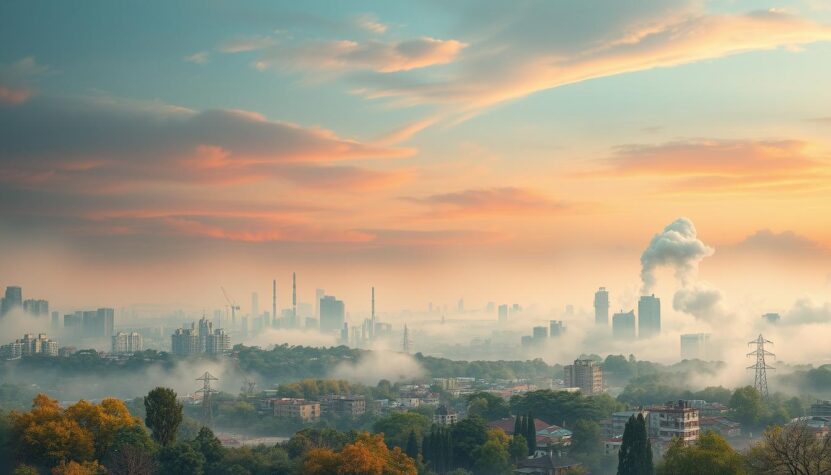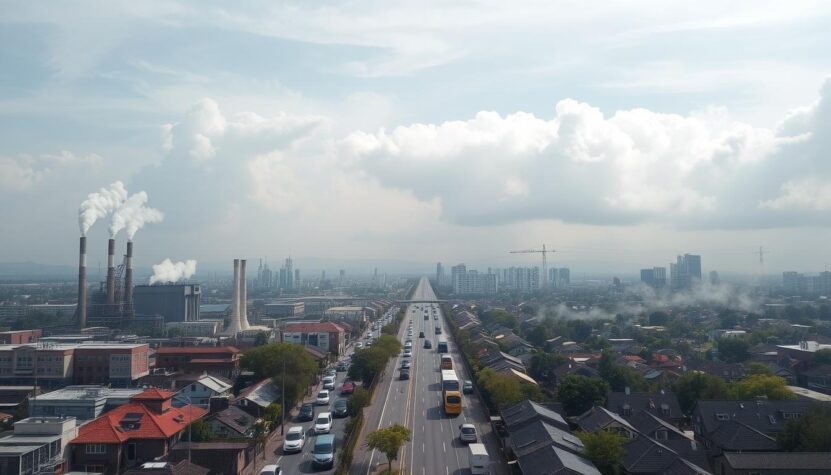In today’s world, understanding the implications of air pollution is essential, as it profoundly affects both our health and the environment. Within the broader category of air pollution lie specific pollution types, including chlorofluorocarbons (CFCs) and smog. These substances not only pose a threat to air quality but also have far-reaching consequences. CFCs are infamous for their role in ozone layer depletion, contributing to increased risks of skin cancer and other health hazards due to elevated levels of harmful UV radiation. On the other hand, smog arises from the interaction of sunlight with various pollutants, creating an immediate concern for public health.
Through this article, you will delve into the mechanisms of how CFCs and smog contribute to environmental pollution, their health impacts, and ways to mitigate their negative effects. You will gain insights into how these elements intertwine, worsening air quality and exacerbating global warming, highlighting the urgency to adopt sustainable practices and support regulations that aim to combat these pollutants.
What Is Air Pollution?
The definition of air pollution encompasses the presence of excessive harmful substances in air. These pollutants can take various forms, including gases, solid particles, and liquid droplets. Common harmful substances in air include particulate matter, nitrogen dioxide, sulfur dioxide, and carbon monoxide, each originating from both natural and anthropogenic sources.
Air quality issues have grown increasingly critical since the Industrial Revolution. Major contributors to air pollution include fossil fuel combustion, vehicle emissions, and industrial waste. Notably, cities like Los Angeles are known for their smog levels, while regions such as Italy and Poland have faced severe air quality challenges in Europe.
Statistics reveal alarming trends: according to the State of Global Air Report, approximately 8 million people globally died from air pollution exposure in 2021. Fine particulate matter, which can harm respiratory health, is measured in micrometers, with ultrafine particulate matter measuring at 0.1 micrometers or smaller. Understanding the sources and implications of air pollution remains vital for improving public health and environmental sustainability.
What Are CFCs?
Chlorofluorocarbons, or CFCs, represent a group of man-made chemicals that have had extensive applications since their creation. Understanding the definition of CFCs and the history of chlorofluorocarbons is crucial in grasping their impact on both the environment and daily life.
Definition and History of CFCs
The definition of CFCs refers to compounds primarily consisting of carbon, chlorine, and fluorine atoms. Initially developed in the 1920s, these substances found widespread use due to their effectiveness and stability. By the mid-20th century, the history of chlorofluorocarbons took a concerning turn as researchers began to understand their role as ozone-depleting substances. The scientific community raised alarms about their ability to break down ozone molecules in the atmosphere, leading to increased ultraviolet (UV) radiation reaching the Earth.
CFCs gained notoriety for their contributions to ozone depletion, culminating in the adoption of the Montreal Protocol in 1987, which sought to phase out the production and use of these harmful compounds. Despite these efforts, traces of CFCs remain in the atmosphere, with studies indicating that almost all CFC-11 ever produced is still present.
Uses of CFCs in Everyday Products
Despite the known dangers, common uses of CFCs have persisted in various everyday products. Their applications include:
- Refrigerants: Used in refrigeration and air conditioning systems, CFCs maintain optimal temperatures.
- Aerosol Propellants: Found in personal care and household products, CFCs help dispense these items effectively.
- Foam-Blowing Agents: Employed in manufacturing, CFCs assist in producing foam insulation and packaging materials.
Even with advancements leading to alternative materials, many older items still contain CFCs, which highlight a continuing need for awareness regarding their impact and proper disposal. Continued monitoring of CFC applications remains critical as nations strive to adhere to international regulations and combat the environmental issues associated with these chemicals.
| Application | Details |
|---|---|
| Refrigerators | CFCs are widely used in cooling systems to maintain low temperatures. |
| Aerosol Cans | They serve as propellants in various consumer products such as deodorants and hair sprays. |
| Insulation Materials | CFCs are utilized as foam-blowing agents in the manufacture of insulation products. |
How CFCs Contribute to Air Pollution
CFCs play a significant role in the increase of air pollution levels. Understanding the ozone depletion mechanism associated with CFCs and ozone layer damage reveals critical insights into environmental health. These substances are not only harmful to the ozone layer but also contribute to various air pollution sources, affecting both human health and ecosystems.
Mechanism of Ozone Layer Depletion
When CFCs are released into the atmosphere, they eventually rise to the stratosphere where ultraviolet (UV) radiation breaks them down. This process releases chlorine atoms, which react vigorously with ozone molecules, leading to ozone depletion. As a result, the protective layer that absorbs the majority of harmful UV radiation is compromised.
The notorious “ozone hole” over Antarctica is a visible outcome of this phenomenon. The depletion of ozone allows an increase in UV exposure on Earth, directly affecting human health by raising the risks of skin cancer and other serious health issues. The consequences also extend to the environment, impacting plant life and contributing to climate change through the greenhouse effect.
In addition to this, CFCs function as potent greenhouse gases, trapping heat in the atmosphere. This dual impact underscores the severity of CFCs in not only depleting the ozone layer but also worsening air quality through the formation of smog, which derives from multiple air pollution sources such as vehicle emissions and industrial discharge.
| Impact of CFCs | Effect |
|---|---|
| Ozone Layer Depletion | Increased UV radiation exposure |
| Health Risks | Higher incidence of skin cancer and immune deficiencies |
| Climatic Effects | Contributes to global warming |
| Environmental Impact | Damage to ecosystems and biodiversity |
What Is Smog?
Smog represents a serious form of air pollution resulting from a mixture of various pollutants in the atmosphere. Understanding the different types of smog helps in grasping its impact on health and the environment. Both photochemical smog and sulfurous smog emerge from distinct causes and conditions, leading to varying health risks and environmental consequences.
Types of Smog: Photochemical and Sulfurous Smog
Two primary types of smog exist: photochemical smog and sulfurous smog. Photochemical smog typically occurs in urban areas during warm, sunny weather when sunlight reacts with pollutants from vehicles and industrial sources. This type not only creates visual haze but also produces harmful compounds like ground-level ozone. On the other hand, sulfurous smog arises from the burning of fossil fuels containing sulfur, manifesting as thick fog often seen in heavily industrialized regions. Both types highlight the critical role of pollution contributors in elevating air quality issues and public health risks.
Causes of Smog Formation
The causes of smog formation are diverse and stem from numerous sources of smog. Major contributors include:
- Emissions from motor vehicles
- Industrial emissions
- Burning of fossil fuels
- Coal emissions
- Forest and agricultural fires
In urban settings, high traffic volumes, low air circulation, and temperature inversions significantly enhance smog levels, resulting in unhealthy air quality. As smog lingers, it can lead to serious health complications, particularly among children and adults who engage in outdoor activities. Awareness of these factors is essential for addressing the pressing issue of air pollution.
Which Type of Pollution Includes CFCs and Smog?
Both CFCs and smog fall within the broad spectrum of air pollution. Understanding the different types of pollution enhances the ability to address them effectively. CFCs, or chlorofluorocarbons, are synthetic compounds primarily associated with ozone layer depletion. Their unique chemical properties allow them to persist in the atmosphere for extended periods, contributing to air pollution and the destructive impact on the ozone layer.
Smog, on the other hand, is characterized by its formation from immediate and concentrated emissions. Comprising nitrogen oxides (NOx) from vehicle exhaust combined with sunlight, smog presents a significant challenge for air quality. This air pollution distinction is critical, as it illustrates how different pollutants can affect both the environment and public health in various ways. Addressing these pollutants is crucial not only for improving air quality but also for combating broader environmental issues.
| Type of Pollution | Key Characteristics | Impact on Air Quality | Examples |
|---|---|---|---|
| CFCs in Air Pollution | Chemically stable, long-lasting | Depletes ozone layer | Aerosol sprays, refrigeration |
| Smog | Formed by NOx and sunlight | Impaired visibility, respiratory issues | Urban areas, industrial zones |
Health Impacts of CFCs and Smog
Understanding the health impacts of CFCs and smog reveals critical information about respiratory problems and long-term consequences for your health. Exposure to these pollutants is linked to significant respiratory issues such as asthma, bronchitis, and even lung cancer. The effects of smog, particularly the high concentrations of particulate matter and ground-level ozone, cause both immediate health risks and chronic conditions that can worsen over time.
Respiratory Issues and Long-Term Effects
Smog respiratory issues contribute immensely to various health challenges. People who live in polluted areas often experience short-term irritation, which can escalate into chronic diseases. The health impacts of pollution extend beyond the immediate experience; studies indicate that prolonged exposure can lead to lasting damage, impacting lung function and overall well-being. The data suggest a direct correlation between air pollution and the rising rates of respiratory diseases. In the U.S., nearly 30,000 deaths are attributed to fine particle pollution each year, highlighting the urgency of addressing health impacts of CFCs and smog.
Impact on Vulnerable Populations
Vulnerable populations and air pollution create a troubling relationship, with at-risk groups like children, the elderly, and those with pre-existing health conditions facing heightened dangers. These demographics often experience more severe health outcomes. For instance, the rate of asthma in children has alarmingly increased, with estimates indicating that children develop asthma at more than double the rate compared to twenty years ago. Pregnant women and older adults are particularly susceptible to the long-term health effects related to CFCs and smog exposure. It remains essential to understand the specific risks posed to these populations to foster effective public health strategies and protection measures.

| Health Issue | Potential Effects | At-Risk Groups |
|---|---|---|
| Asthma | Increased development rates and exacerbated symptoms | Children, elderly |
| Bronchitis | Prolonged coughing, discomfort, long-term respiratory damage | Elderly, those with lung disease |
| Lung Cancer | Higher risk of incidence from prolonged exposure | Smokers, non-smokers with high pollution exposure |
| Heart Disease | Increased risk due to air quality | Individuals with existing conditions |
| Respiratory Infections | Higher susceptibility and longer recovery times | Children, elderly |
Environmental Damage Caused by CFCs and Smog
CFCs and smog generate substantial environmental damage, affecting not only the air quality but also the delicate balance of ecosystems. The impact on ecosystems from these pollutants can be profound, leading to significant biodiversity loss. The increase in ultraviolet (UV) radiation due to ozone layer depletion from CFCs adversely affects various plant and animal species. In addition, smog reduces sunlight penetration essential for photosynthesis in plants, thus harming agricultural crops and natural forests.
Effects on Ecosystems and Biodiversity
The environmental damage from smog and CFCs alters habitats and contributes to changes in species distribution. Pollutants such as nitrogen oxides and sulfur dioxide, primarily from combustion sources, lead to the formation of acid rain. This phenomenon can severely harm aquatic ecosystems and forests. The risks posed to plants and crops translate into biodiversity loss, which can disrupt food webs and reduce resilience against environmental changes.
Global Warming Contributions
CFCs, categorized as potent greenhouse gases, have a lingering effect on global warming, capturing heat in the atmosphere long after their release. The interplay between air pollution and climate change intensifies as rising global temperatures create conditions conducive to smog formation. Carbon dioxide, methane, and other greenhouse gases contribute to the warming effect, amplifying the challenges posed by air pollution. A collaborative approach to tackling these issues is vital for mitigating the ongoing effects of these pollutants on our planet.
Sources of Air Pollution
Air pollution has various origins, stemming from both human activities and natural processes. Recognizing these sources is crucial for developing effective strategies to combat pollution and safeguard public health.
Human-Made Sources vs. Natural Sources
Human-made air pollution sources significantly impact air quality. Major pollution contributors include:
- Industrial emissions
- Vehicle exhaust
- Fossil fuel combustion
On the other hand, natural pollution sources also play a role. Wildfires and volcanic eruptions can release substantial amounts of pollutants into the atmosphere. Understanding the difference between these two types aids in creating specific regulations to mitigate their effects.
Major Contributors in Urban Areas
Urban areas often experience heightened levels of city pollution due to concentrated emissions from various sources. The following urban air pollution sources are noteworthy:
- Motor vehicles, which release nitrogen oxides and particulate matter.
- Factories, contributing to sulfur dioxide and various volatile organic compounds.
- Construction activities that disturb dust and generate particulate matter.
In places like Los Angeles, known for its smog, regulations are essential to control emissions. Developing nations may struggle more, as larger cities often face stricter air pollution levels due to inadequate regulations and access to cleaner fuels.

| Pollution Source | Type of Pollutant | Impact on Health |
|---|---|---|
| Vehicle Exhaust | Nitrogen Oxides, Particulate Matter | Asthma, Lung Damage |
| Industrial Emissions | Sulfur Dioxide, Volatile Organic Compounds | Respiratory Problems, Cancer |
| Construction Activities | Dust, Particulate Matter | Respiratory Irritation |
As research suggests, poor air quality affects millions globally, emphasizing the importance of addressing both human-made and natural pollution sources for a healthier environment.
How to Reduce CFCs and Smog
Taking proactive steps to reduce air pollution can have significant positive effects on both the environment and public health. Your individual actions against smog and the collective support for effective policies are essential in this ongoing battle. Simple yet effective eco-friendly choices can lead to sustainable improvements in air quality.
Individual Actions to Mitigate Air Pollution
You can make a real difference through a variety of eco-friendly choices. Here are some strategies to consider:
- Opt for CFC-free products whenever possible, reducing demand for harmful substances.
- Use public transportation, bike, or walk instead of driving, as this minimizes emissions significantly.
- Enhance energy efficiency in your home by using energy-efficient appliances and optimizing heating and cooling systems.
- Engage in tree-planting initiatives as trees naturally filter pollutants and improve air quality.
- Stay informed about air quality warnings and adjust your outdoor activities accordingly on high pollution days.
Government Regulations and International Treaties
Government action on CFCs and comprehensive air pollution regulations play a vital role in shaping a cleaner future. Key initiatives include:
- The Clean Air Act, enacted in 1970 in the United States, has established critical standards for hazardous air pollutants.
- International treaties, such as the Montreal Protocol, aim to eliminate ozone-depleting substances, promoting global cooperation for pollution reduction.
- Countries like China are developing robust regulatory frameworks to tackle air pollution amid rapid industrialization.
- Legislation, such as the United Kingdom’s Clean Air Act passed in 1956, demonstrates the positive impact of responsive measures to air quality crises.
Conclusion
Air pollution, particularly the impact of CFCs and smog, poses pressing health and environmental challenges that require your immediate attention. Understanding the consequences of these pollutants on both human health and ecosystems is vital for fostering effective solutions. With common air pollutants such as carbon monoxide, sulfur dioxide, and nitrogen oxides derived from industrial activity and vehicle emissions, the link between these sources and the deterioration of air quality is clear.
To mitigate the impact of CFCs and smog, you can implement individual actions and support government regulations aimed at air pollution reduction. Combustion of fossil fuels, mining activities, and the operational practices of factories and vehicles significantly contribute to this pressing issue. Recognizing that these actions lead to severe health problems—ranging from heart disease to respiratory ailments—is crucial for encouraging a collective commitment to cleaner air initiatives.
Looking to the future, your role in promoting a clean environment is paramount. By making informed choices and advocating for policies that mitigate the release of CFCs in the environment, we can work together to ensure a healthier planet for generations to come. The path to air pollution reduction starts with awareness, and every step you take counts in the fight for a sustainable future.
